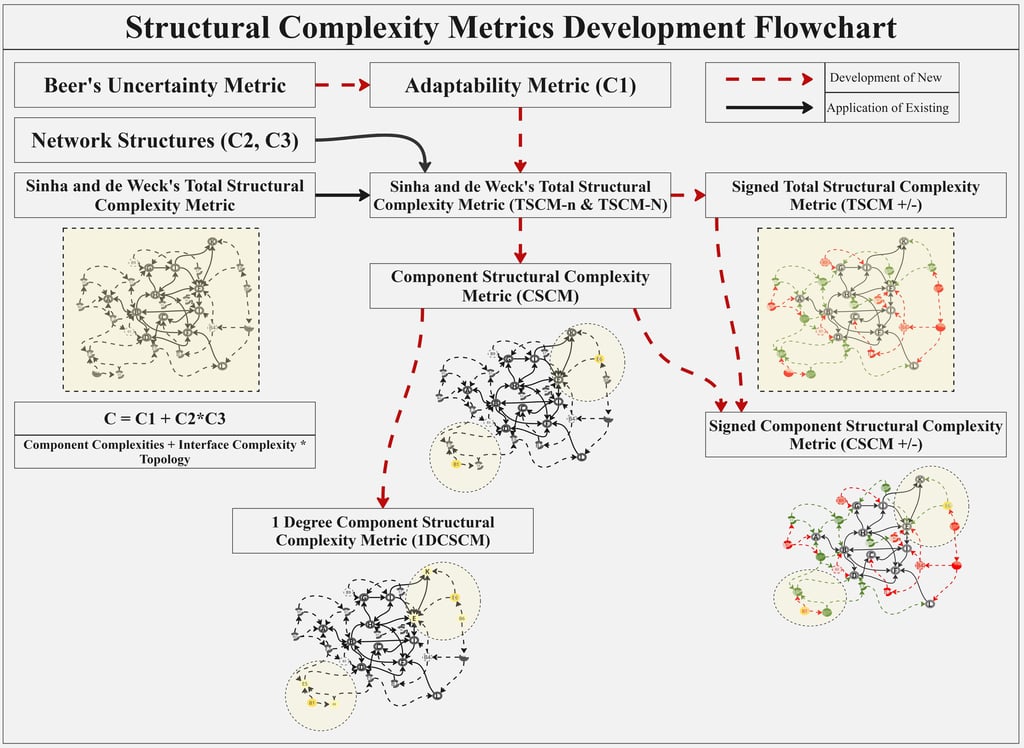Integrating Quantitative Approaches
Quantitative Approaches
In complex human-technical systems, failure rarely stems from one broken component. It emerges from the interactions between constraints, policies, infrastructures, and the people navigating them. To make those dynamics visible and measurable, I use network analysis, structural-complexity metrics, and mixed-methods modeling to capture both the topology and behavior of systems under strain. By mapping relationships across hospitals, payers, ministries, and communities, and quantifying how those relationships concentrate control or propagate breakdown, I can diagnose where coordination fails and why interventions don’t stick. These analytical tools transform what is usually invisible complexity into strategic insight, highlighting the interdependencies that matter most for performance and resilience.
Novel Developments
In this work, I developed two new complementary tools: the Adaptability Metric and the Systems Performance Indicator (SPI). The Adaptability Metric evaluates the changeability of barriers and enablers: how tightly they’re embedded in organizational structure, how dependent other problems are on them, and how sensitive the system is to their improvement.
The SPI provides a holistic indicator of system health, combining measures of structural complexity, operational strain, and resilience potential. Together, these tools go beyond simply mapping a system; they quantify the leverage within it, where targeted action yields outsized reduction in disorder. These methods emerged from real organizational and policy constraints in Buenos Aires healthcare networks, but they are intentionally generalizable to manufacturing, supply chains, and industrial strategy.
Why It Matters
Organizations don’t lack data, they lack clarity about what to do next. When leaders face competing stakeholder demands, risk-averse environments, or resource-limited conditions, the question becomes: Where will change actually make a difference? By quantifying adaptability and system performance, these methods allow decision-makers to rank interventions not just by their expected impact, but by their feasibility and systemic payoff. That’s what it means to fight entropy: not to eliminate complexity, but to strategically counteract the forces that push systems toward fragmentation, waste, and failure. Whether in a hospital network, a defense supply chain, or a factory floor, this work provides a structured way to reduce uncertainty and build systems that adapt, endure, and improve through disruption.


Visual representation of the Adaptability Metric calculations
Extending Structural Complexity Metrics
A core contribution of my dissertation is the advancement of network-based Structural Complexity Metrics to better suit socio-technical, human-driven systems. I built on Sinha & de Weck’s Total Structural Complexity Metric (TSCM), maintaining its foundations while extending it in several practical and theoretical directions. These modifications were required to support the Systems Performance Indicator Tool and the goal of converting qualitative evidence into ranked strategic action.
Component Structural Complexity Metric (CSCM)
Traditional TSCM provides a system-or-subsystem-level view of structural burden, but operational breakdowns often originate from individual components whose influence gets lost in aggregation. The CSCM addresses this visibility gap by re-calculating the TSCM for each component independently, allowing precise measurement of how much complexity a single barrier or enabler introduces into the system. This was necessary in the healthcare case where different barriers, such as the lack of providers and inflation crisis, had enormously different ripple effects. CSCM quantifies those differences with mathematical rigor, converting narrative frustrations into rankable intervention opportunities. From a methodological standpoint, CSCM builds directly on my Adaptability Metric values (C1) for each node, which give grounded human-experience-based complexity, not just topology. This produces a metric that resonates with how systems actually behave under strain: certain problems cause cascading delay, others are simply annoyances.
Why it matters
CSCM reveals the 10–20% of components that exert disproportionate drag on operations, giving organizations a focused punch list for decision-making. It turns “everything is complicated” into “start here.”
One-Degree Component Structural Complexity Metric (1DCSCM)
Systems rarely fail in isolation. The complexity of one component often emerges from the neighbors it depends on. The 1DCSCM incorporates neighborhood effects, capturing the complexity of the directly connected components rather than treating them as independent actors. In healthcare, this reflects a real operational phenomenon: a given intervention may be simple on its own, but if every neighbor is extremely complex, its local simplicity becomes more relevant for directing cascading interventions. 1DCSCM surfaces these cascade points where multiple simple nodes feed into systemic chokepoints. Mathematically, this metric represents the bridge between network science and process mapping. It allows you to measure how local complexity scales up, without losing interpretability.
Why it matters
This metric shows where interventions amplify; where resolving bottlenecks produces system-wide performance gains, not just local improvements. It's the metric operations leaders wish they always had:
Signed Structural Complexity (Signed-TSCM and Signed-CSCM)
Not all connections or parts of the system make systems worse. Some enable adaptability and reduce entropy. Traditionally, complexity metrics penalize all connectivity equally. But in human-technical systems, relationships have meaning: some are cooperative, others are antagonistic, and many depend on context. Signed-TSCM and CSCM integrate polarity (positive vs. negative) into both the structural term and the interface term, revealing where the system is supporting its own function and where it is actively undermining it. For example, collaboration between institutions smooths patient movement; bureaucratic rules halt that movement. Signed-TSCM and CSCM mathematically distinguishes these forces, making resilience vs. fragility spatially explicit in a network. This approach also enables quantification of trust, a major insight from my fieldwork, as trust increases resilience while mistrust amplifies uncertainty and coordination breakdown.
Why it matters
Executives can’t remove all complexity. Some complexity is necessary structure. Signed metrics let leaders focus on harmful complexity, reinforcing what works rather than flattening everything. Where structure concentrates relationship burden and where change is feasible, performance can be shifted. Signed-SCM points directly to where those shifts are most defensible.


Visual representation of the the development of new structural complexity metrics